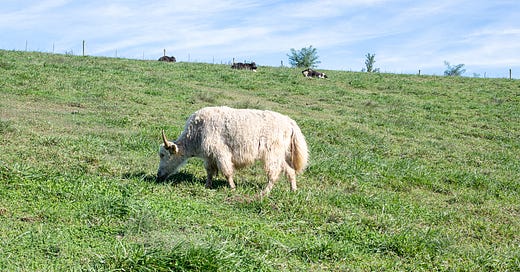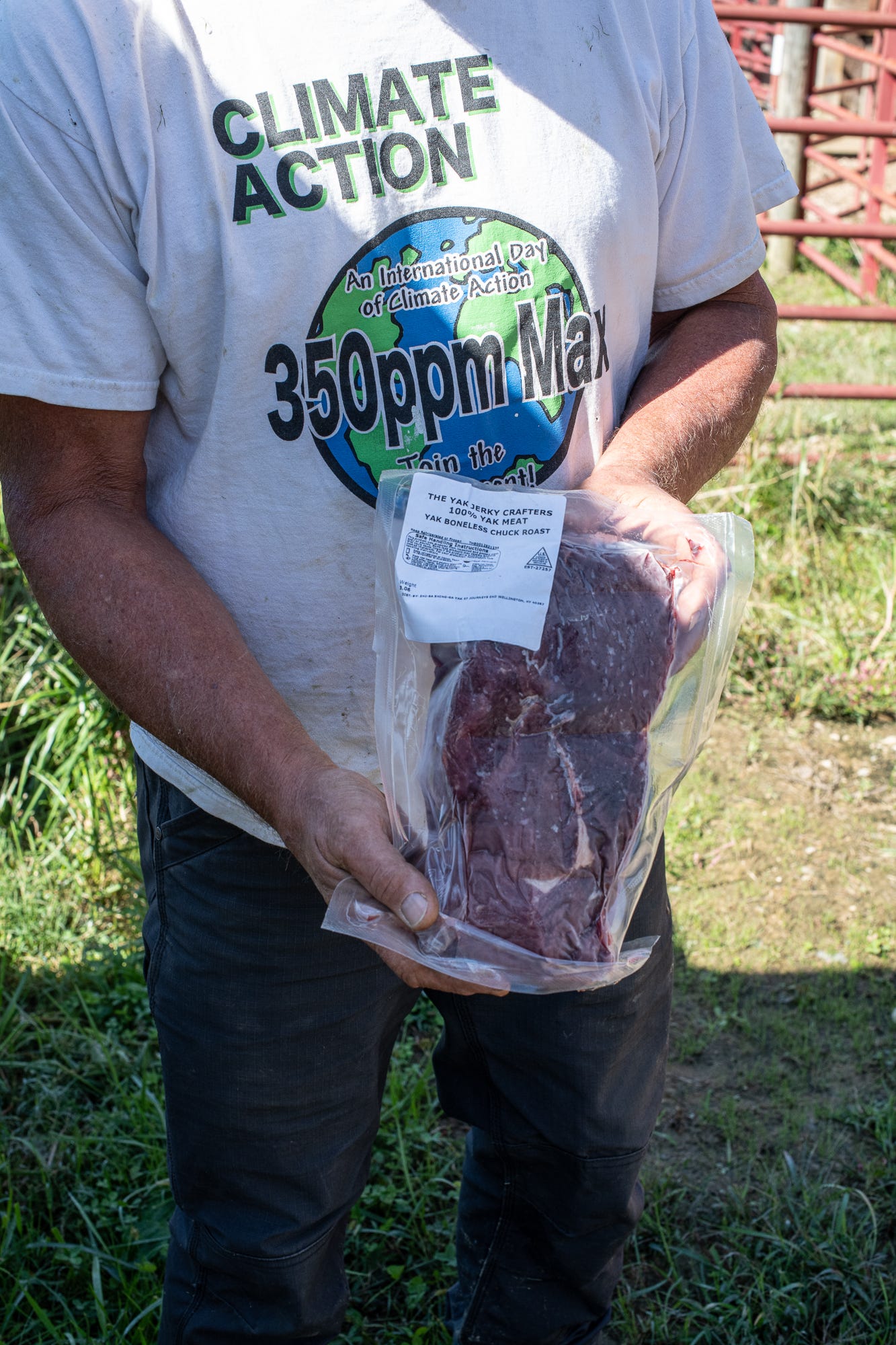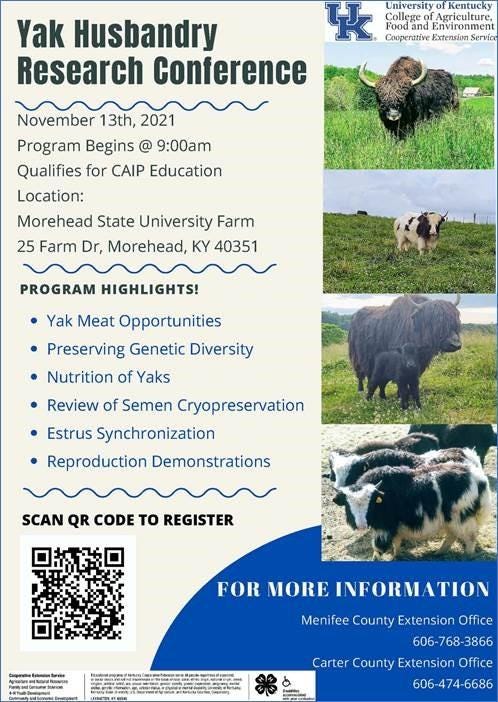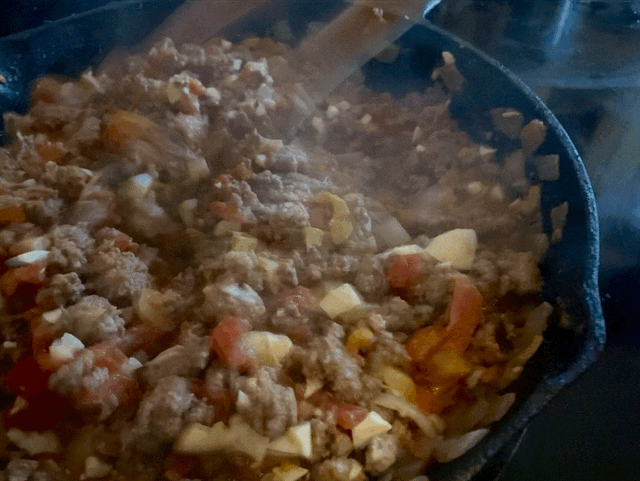Could Yak Crossbreeding Make Kentucky Beef More Sustainable?
"This could be a game changer for small farmers who could get more money for their meat."
Welcome back to Yak Week on The Goldenrod! If you missed Tuesday’s newsletter, start here to read more about the work Gregor Dike is doing on his yak farm in Menifee County.
It’s well known that the process of raising and grazing beef cattle is a huge contributor to our current climate crisis, producing 62 percent of agricultural emissions overall and four to eight times that of chicken, pork or eggs per gram of protein. But did you know that Kentucky is a major contributor to this as the largest beef producing state east of the Mississippi?
Yes, you read that correctly. Many lifelong Kentuckians are surprised to learn that we have such a robust beef cattle industry in the state: with around 983,000 head of cattle, Kentucky ranks eighth in the nation for “most beef cows” and accounts for 3.15 percent of the collective national herd.
With big agricultural business comes big lobbies (and big gatekeepers) largely uninterested in trying new, more eco-friendly approaches to meat. Dike, though, has a plan that could not only introduce a more sustainable and healthier meat source (yaks!) to Kentucky, but help smaller farmers carve out a novel “specialty product” for themselves, all while involving the old guard beef community.
His idea? Crossbreed yaks with Angus cows using artificial insemination for an all-new type of marbled, Omega-3 rich meat.
Yangus? Aaks? I’ll keep workshopping names over here, but back to our conversation:
Gregor Dike: Something that I think a lot of people don't necessarily know is that Kentucky is a huge beef producing state.
Sarah Baird: Yep, huge. [Ed. Note: It’s the largest beef producing state east of the Mississippi River.]
GD: And the system is really geared toward beef. So, for instance, if I wanted to bring a yak to the Kentucky State Fair or some of these other shows, I can't do it. Farm Bureau has a big show—nope.
SB: Really?
GD: It's just closed. The way they organize it, you really can't get the yaks in because you usually don't tie them up like a show animal, you put them in a pen. And they used to have pens [at the shows], but they've cut it out. They won't expand to allow new animals in.
SB: Do you think one of the biggest barriers is that Kentucky’s leaders are holding on to this limited idea of beef as end-all, be-all?
GD: They don't know what yaks are. They think in terms of buffalo, which they're not. Buffalo are hard to raise just because they're so big and the fencing has to be, like, all steel or something. So, I think part of it is they’re thinking about different costs. I also think they're hooked on beef, and people don't want to try anything new. But some people want them as a novelty animal. The problem is, if you're going to start that and do it for meat, you really have to create your own market.
SB: Right.
GD, looking at the ground: You really have to teach people. And that's slow. And the stores don't get it. They'll say, “Well, no, that's too expensive.” They're not going to pay that much. And the price of yak meat is high, but it's about the same as bison.
SB: I was going to say, what are we talking when we say “high”?
GD: Well, the going rate now if you're selling ground yak, say at a market or online, is like $14 a pound. And then your steaks, those are $20 to $40 depending on who's doing it. When you think about it, if you figure out the price and you divide it into McDonald’s sizes—slice it up—and you take that small amount and say, “OK, that's a McDonald's size meal” then yak meat actually comes out cheaper. It’s just a different type of meat.
SB: And better for you, right?
GD: We took an animal that was grass fed, had it slaughtered, and sent some of the meat to a lab to have it checked. They came back with the results. It was about 20 percent protein and about 1 percent Omega-3, I think, along with some linoleic acid and things like that. So that’s really good. [Ed. Note: For reference, salmon typically has 4,123 mg of Omega-3 per serving.]
SB: That’s amazing.
GD, smiling: Yeah. That's neat. So, my thought was that, if I had an Angus farm, what I could do is crossbreed the Angus cattle with the yaks. And that would bump the meat quality up because of the yak meat, then the price stays the same or goes up, because the supply is smaller than the demand. And if you crossed that Angus with a yak and you advertised it as Angus and yak, you’d have a specialty thing. You could have your own niche and probably do quite well.
SB: Sounds like a great idea for someone in Eastern Kentucky…
GD: The odd thing, which I don't like, is USDA has said if it's 39 percent yak meat, you can call it yak.
SB: What?
GD: Yeah, so if you did a 50/50 breed cross—Angus and yak—you could sell it as yak meat, but of course it will taste different because it is much more marbled and it'll be healthier than the Angus. But I would market it as half yak, half Angus and make it a specialty thing.
SB: Why hasn’t anyone taken advantage of that yet?
GD: I mean, these options are there, and this thing we're doing November 13th [Yak Husbandry Research Conference] is partly to try to lure in some beef people to consider the idea of crossbreeding. I'm not sure we will here at this one, but we got a grant from USDA to look at artificial insemination [AI] with yak, because nobody really does it.
SB: Neat!
GD: And if we get that down, that opens the door. Like if you said, “Well, I'd like to have five yaks, but I don't want a bull” then that would get you out of the bull department. And so the minute you're out of that, life is easy.
SB: Life without bulls—much easier.
GD: And then for Joe Angus breeder, he can come in and do half his cows the way he typically breeds then through artificial insemination—but with yaks. Give it a try. They'll grow faster because they’re half Angus, and he could advertise the meat differently.
SB: That's a great idea.
GD: The hope with the event at Morehead is that we pick up some people who either want to try yaks or someone who want to try crossbreeding, and we slowly get it out there. So, that's the goal.
SB: This seems like a much bigger deal for potentially reshaping agriculture in the region than just yak products like jerky or wool.
GD: I mean, this could be a game changer for small farmers who could then get more money for their meat. And for the big people who could maybe stabilize their meat prices. And it's also environmentally sounder, and healthier, because people aren't going to give up meat. But meat doesn't turn me on usually. I do not like the meat side of the business.
SB: What’s that like, being someone who doesn’t like meat but works with yak, uh, meat?
GD: I mean, you have to do it in order to sell it, right? And I do think the yak meat is the way to go. It's just not something, at this point, that's going to keep at a store. Somebody said, “Well, sell it to Kroger.” Like, why? There’s five minutes’ worth of yak meat available, you know?
SB: That makes sense. If you had enough farms in the region with yaks, do you think that it could ever reach the point where yak meat goes mainstream locally? [Greg shakes his head] No?
GD: I mean, yeah. Theoretically it could. There was a slaughterhouse—there is a slaughterhouse, it's just gone down the drain—that had a contract to do the beef for slaughter for Kroger in Kentucky. And he was gearing up to do 120 head [of cattle] a day for that.
SB: That’s a lot!
GD: For yaks, 120 a day? In 70 days, you'd wipe out the whole US herd. So, no.
SB: Yeah. Okay. Nope.
GD: But if you do crossbreeding and stuff—so the US herd is now bigger and the beef animals are kicking in with higher quality meat—then you could make a bigger dent in it. You could offer it. Like, it would be there all the time. You’d have some people who might buy your Angus, and other people who buy your crossbred Angus-and-yak, and you might have enough where you can even have a little niche of real yak on-and-off for people to try.
SB: Essentially, bringing in two brand new, healthier forms of protein to the mainstream.
GD: Right, but really, it's the crossbreed that's going to be the most doable and best option for big stores.
All Photos: Will Major
Argentinian-Style Yak-Stuffed Peppers
The Goldenrod Original™ Recipe
Greg provided me with some ground yak meat to play around with, and I decided to pair this delicate, rich meat with the flavors from a traditional Argentinian beef empanada and stuff it inside a bell pepper. The yak meat is juicy and umami-rich—like bison, but tenderer—and all the ingredients in this recipe minus the yak can be found at any grocery store across the region, from Food City to Kroger. If you use ground beef in place of yak, plan to brown it for 3-4 minutes longer on the stovetop. If you’d like to try out local yak, Zhi-ba Shing-ga will surely be able to help.
Argentinian-Style Yak-Stuffed Peppers
Yield: 4 medium-sized stuffed bell peppers
Active Time: 25 minutes
Total Time: 1 hour, 10 minutes
Ingredients
1/2 medium onion, finely chopped
3 garlic cloves, finely chopped
1 1/2 tablespoons olive oil
1/2 teaspoon ground cumin
1/4 teaspoon paprika
3/4 teaspoon dried oregano
1/2 teaspoon salt
1/2 teaspoon black pepper
3/4 pound ground yak
1 cup wild rice
2 tablespoons golden raisins (optional)
2 hard-boiled eggs, finely chopped
3 tablespoons pimiento-stuffed olives, rough chopped
1 (14-ounce) can whole tomatoes in juice, drained and chopped, with 3 tablespoons reserved tomato juice
4 medium-sized bell peppers, color of your liking
Ahead of time:
- Cook and drain your wild rice. Set aside.
- Using a paring knife, hollow out the center of your bell peppers (removing the stem, seeds and membrane) to create a vessel for the yak meat mixture. In order to prevent the peppers from tipping over—and making a mess—cut the rounded tips off the bottom of the peppers to create a flatter surface for them to stand on. Do not cut all the way through the bottom of the pepper or you’ll have a different kind of leakage: just a little nip/tuck off the bottom will do.
To Assemble:
1. Preheat oven to 350°F.
2. In a medium bowl, combine ground yak meat with cumin, paprika, salt, pepper and oregano. Massage meat and seasoning together using a fork or—ideally—clean hands.
2. Wash hands thoroughly.
3. Heat olive oil in non-stick skillet or cast iron until glistening, about two minutes.
4. Add onion and cook until soft but not-quite translucent, about 7-8 minutes, then add garlic and sauté 1-2 more minutes.
5. Add tomatoes and cook until excess liquid reduces slightly, about 5 minutes.
6. Add seasoned ground yak and cook until just browned, about 6 minutes. (The yak will continue to cook in the oven and is—as I’ve mentioned—very lean.)
7. Remove yak meat mixture from the heat.
8. In a large clean bowl, combine meat-and-tomato mixture, cooked rice, egg, olives and raisins. Toss gently until mixture comes together.
9. Arrange hollowed-out bell peppers in an 8x8 baking dish (or sheet pan) and scoop 1-2 tablespoons of yak mixture into the middle of each.
10. Place in oven, and bake until peppers begin to soften, about 40-45 minutes. If mixture appears to be drying out, ladle reserved tomato juice over top.
11. Allow to cool for five minutes, then serve warm topped with your choice of cheese (if that’s your thing).











